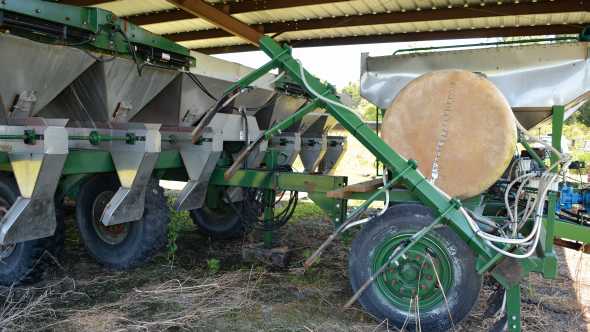Farming Fertility Practices Evolving With Environment In Mind
The thinking about fertilizer applications has evolved over the past 20 years driven not only by water quality concerns and regulation, but also attention to the grower’s bottom line. Sustainability and efficiency are inextricably tied and water quality has benefited from a focus on these areas over the years.
According to Lara Moody, senior director of stewardship and sustainability for The Fertilizer Institute, smart nutrient management and water quality go hand-in-hand.

In Florida potato country, growers are banding dry fertilizer to protect water quality while maintaining yields.
Photo by Frank Giles
“Depending on the crop, fertilizer can account for as much as 40% of the input costs on farming operations,” she says. “For this reason alone, managing nutrients is important. Productivity and farm profitability are a high priority on the farm, but increased concerns about water quality certainly play an increasing role in nutrient management considerations.”
Moody adds that growers should aim to keep fertilizer in the plant root zone to maximize utilization and reduce potential of leaching.
“The right way to think about efficiency gains in fertilizer use is to think about optimization per unit of yield,” she says. “In other words, the goal is not necessarily to reduce fertilizer inputs, but to reduce inputs per unit of yield while increasing productivity without effecting product quality.”
Growers have an increasing number tools available to them for more precision application of fertilizer. The industry refers to this as the 4Rs — Right fertilizer source, at the Right rate, Right time, and in the Right place.
“In a state like Florida, this can mean practices like fine tuning the nutrient blend to extend its availability to the crop, dialing in application rates and timing with split applications at variable rates to reduce leaching, and placing fertilizer at the right location in the bed to maximize uptake by the roots,” Moody says. “Other practices like cover crops are becoming increasingly important nutrient and soil management tools.”
Focusing On Alternative Approaches
Alternative approaches to maximize fertility inputs while reducing potential water quality impacts are proven in the field. David Holden is a certified crop consultant and owner of Holden Research and Consulting based in Oxnard, CA. He has been working with growers on approaches to reduce nitrogen use in crop production.
“I have had a small grant from the California Celery Research Advisory Board for the past three years to look at the use of supplemental products (Humic acid, seaweed, biologicals, etc.) to help in reducing nitrogen use,” Holden says. But, we want to maintain similar production as to what is obtained with 100% normal nitrogen use (approximately 400 pounds nitrogen per acre per season). I have conducted further similar research under contract to individual manufacturers and distributors of similar products. We also have looked at a few privately funded studies in lettuce.”
Holden adds regular monitoring helps optimize fertilizer applications no matter the form they come in. Soil and in-season leaf and petiole analysis are critical to balancing applications and optimum yields. The same goes for efficient irrigation — weather monitoring and soil moisture monitoring can maximize water savings and usage. Of course, with the California drought, Holden says there’s not a lot to monitor or potential for fertilizer leaching.
As far as grower adoption of new products or technologies to save water or reduce nutrient inputs, Holden says it takes time and growers want to see proof.
“Even when presented with strong evidence, adaptation takes some time,” he says. “In my area, I would say we are 85% to 90% adoption of low volume irrigation (tape, drippers, and low-volume sprinklers). We started here in the early 1970s on avocados and citrus, but high adoption probably did not occur until 2000. In the vegetables, tape was introduced in mid-’90s with general adoption probably occurring five years ago.”
Supplements that help with nutrients also have been slower because, in some cases, marketers got the “cart before the horse,” as Holden puts it. There were claims made about products before there was strong evidence of functionality. The evidence of functionality is being established, but there are many products to sort through.
“Only until I or someone else can show the grower the return on investment do they start getting adopted,” Holden says. “But this is quite common and I am constantly showing growers how product A or B might help them. The challenge is it is a very noisy market out there with hundreds of common products that only brings confusion to the marketplace.”
Regulation’s Role
Moody says growers should expect increasing scrutiny over water regulation in the coming years as federal, state, and local authorities place more pressure on nutrient management in farming.
“The EPA’s Clean Water Act has been very successful at addressing pollutants that are toxic or bioaccumulative,” she says. “Since the Clean Water Act was passed, our nation’s water quality has improved markedly. However, most of the low-hanging fruit has been picked, so there is an ever increasing focus on more complex water quality problems, especially nutrient pollution.
“As we saw in Florida, and as is playing out in other states, the environmental groups and public are pressuring EPA and the states to address nutrient pollution. Nutrient runoff from fertilizer and agriculture contribute to the total nutrient load in many watersheds. Florida recently set numeric nutrient criteria for waters in the state. If nutrients exceed a certain concentration, the water is declared impaired and the state is required to work with point sources and non-point sources to reduce nutrient concentrations in the water.”
These regulations have a direct impact on producers, as is in the Chesapeake Bay, where growers in multiple states have to prepare nutrient management plans and follow best management practices. There is ongoing litigation in Iowa and the Mississippi River Basin that would force EPA and the states to set more strict requirements for nutrients in water. Recently, Ohio passed a law requiring anyone who applies nutrients to go through a training and excludes some application practices.
“Both through litigation or state legislative and regulatory efforts, growers will likely see increased pressure to better manage their nutrients,” Moody says. “Each state is different and has a different approach to working with agriculture. Irrespective of where a grower is located, nutrient runoff and water quality is going to be an increasing area of discussion and potentially regulation.
“From what we have seen so far, growers can help position themselves by adopting best management practices including the 4Rs. This proactive approach helps agriculture show that it is committed to solving the problem and gives them practical options to propose if regulations are adopted.”










